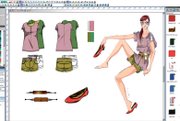Lectra Computes the Design Process
Most of the software solutions attracting the apparel industry have been directed toward the pre-production process, when managing specs, costing and materials becomes important. But French company Lectra is taking a step back, bringing computerization into the design process, well before patterns are even drafted.
Lectra’s answer to speed-to-market from a design standpoint is its new Kaledo Suite, which is aimed at helping designers create collections quickly and efficiently.
Lectra has been promoting Kaledo at various workshops around the country. The company was recently in Orange County, Calif., hoping to attract the area’s surfwear and ready-to-wear makers.
The Kaledo system goes well beyond the functionality of products such as Adobe Illustrator, said Jill Simmons, director of design solutions, who works out of the company’s Cypress, Calif., office. Kaledo was developed with the apparel and textile industries in mind and with the idea that much of the information would be used throughout the supply chain so it could be integrated into production applications such as Lectra’s Fashion PLM as well as other PLM systems. PLM manages all the pre-production points of data that occur in materials management, costing, sampling and other steps.
Using some of the same principles as PLM, Kaledo manages the many points of data involved in organizing a collection and carries the information down the production pipeline.
“When changes are made to color, you have to notify those affected. Some companies can have 100 colorways. Some have 1,000,” Simmons said.
The suite is broken up into three modules: Kaledo Collection, Kaledo Print and Kaledo Knit & Weave.
Textile designs are created for cotton, polyester and other fabrics in the print application, while knit and weave patterns can be crafted in the print and weave modules. Kaledo Collection pulls it all together with the ability to create storyboards.
“It’s one best-of-breed system for all of these areas. It encourages the sharing of information, mapping and processes. It provides a structure [for production],” Simmons said.
In Kaledo Print’s textile-creation application for example, users see a window that reflects actions in real time.
“You don’t have to guess. You see what’s happening immediately,” said Christine Fox, design solutions expert for Lectra.
The system can borrow colors from an accompanying Pantone library. It can also borrow rough sketches from a library created by Los Angeles–based trend agency SnapFashun, or users can create their own sketches.
“Eventually, you can define vectors, styles, fabric under multiple classifications. You can design from scratch and bring it into a pattern DSF file,” Fox explained.
The system was designed to eliminate a lot of the repetitive steps, so users make the minimum amount of data entries and illustrations, Simmons added.
“You can draw on both sides of the garment at the same time. You can keep everything visual and virtual, minimizing what is sent to the sample room,” Simmons said, adding that any changes in color or alterations are automatically updated in an associated program.
Among the new users is Seacaucus, N.J.–based retailer The Children’s Place, which has more than 900 stores in the United States and Canada. The company had been using Lectra’s U4ia software and recently made the transition to Kaledo.
“The trick for us was to incorporate the new tool into our design team of 60 users while still getting our collections out on time,” said Phil Wozny, senior director of merchandising systems for the retailer. “Together with Lectra’s team, we were able to implement a rapid migration strategy to effectively cope with the double challenge of learning a new tool and overcoming issues related to change management. We decided that we would require all users to move to Kaledo without the option of returning to U4ia. And it worked very well, with only seven days of training for each user and not a single delivery delay. We’ve been very pleased. Kaledo offers newer and much richer functionality.” —Robert McAllister






















